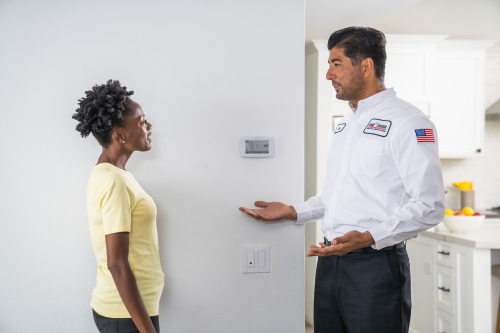
You can keep warm and save money on your heating bills by modifying your thermostat settings to accommodate the upcoming winter in Melbourne, FL. Because winters in Melbourne aren’t as cold as they are in northern places, you’ll need to adjust your thermostat settings accordingly. Making the right modifications can have a dual benefit of improving comfort and reducing energy expenses. Most importantly, it’ll help your heater last longer, which means more reliable heating when you need it most.
Best Temperature to Set the Thermostat To
A temperature between 68 and 72 degrees Fahrenheit is usually ideal for homes in Melbourne during the winter. This temperature range keeps HVAC energy usage to a minimum while also keeping you comfortable and warm. When you’re not at home or sleeping, turning down the thermostat a few degrees can help save more energy and money without sacrificing comfort. A programmable thermostat with smart learning features can save energy by adjusting the temperature according to your routine and temperature preferences.
Factors That Influence the Best Thermostat Settings
While most homes operate well within the 68- to 72-degree spectrum, this range doesn’t apply to all homes and situations. The best thermostat settings for winter in Melbourne depend on a number of factors. External temperature and humidity, indoor insulation and sunlight exposure all play a role.
Outdoor Temperature
Lows in Melbourne can drop into the 50s at night, while daytime highs are mid-60s to low 70s. Compared to colder climates, heating demands in this moderate climate are lower, meaning you can get away with a somewhat lower thermostat setting. Adjusting the thermostat just a couple of degrees lower when it’s warmer outside can save you a considerable amount of money on your heating expenses. For example, if you choose to keep the thermostat at 68 degrees Fahrenheit instead of 72 degrees, you’ll save roughly 10% on your heating costs.
Humidity Levels
Humidity swings in Melbourne throughout wintertime can mess with your heating comfort and efficiency. The dry air that winter typically brings has a way of making inside areas feel much cooler than they actually are. One way to combat this is by making sure the humidity is just right; the more moisture in the air, the warmer you feel. Humidifiers or the humidity control on your thermostat can keep the air from getting too dry, which is also good for your skin and lungs.
Home Insulation
A higher thermostat setting isn’t necessary in homes with good insulation since the heat stays in better. However, a slightly higher temperature may be necessary to make up for heat loss in older and poorly insulated houses.
Sunlight Exposure
The amount of sunshine that enters a room has a major impact on the temperature inside. Homes in Melbourne that receive a lot of sunshine during the day may not need as much heating because of natural warming. You can harness the power of this passive type of solar heating by manually modifying your thermostat settings according to the sun’s behavior. For more convenience, consider using a smart thermostat that monitors your home’s sunlight exposure levels and makes adjustments automatically.
Fan Settings
The widespread consensus is that you should leave your thermostat fan on “Auto” during winter in Melbourne. This feature allows the fan to turn on only when the heating system is active, ensuring a constant temperature without wasting energy.
Humidity Control
Adjust the humidity control feature (if your thermostat has one) to a setting between 30% and 50%. This configuration keeps indoor temperatures comfortable and wards off problems like static electricity and dry skin. It also protects hardwood furniture and fixtures from warping and cracking.
Temperature Offset
A temperature offset option might be helpful if the thermostat is in an area that is noticeably hotter or cooler than the rest of the room. This option ensures the temperature displayed on your thermostat accurately represents the real temperature within your home.
Hold or Override
You can temporarily set a certain temperature by using the hold or override option on a thermostat, which allows you to bypass the programmed settings. This function is great for keeping the home at a constant temperature during special or unexpected situations, like having guests over for the holidays or dealing with a sudden cold snap.
Vacation Mode
If you go away on vacation during the winter, don’t forget about the HVAC system. Instead, use the vacation mode on the thermostat to save electricity or gas by navigating to the thermostat’s settings menu and finding the option for vacation or away mode. Make sure the temperature is set correctly to avoid frozen pipes and keep energy efficiency high while you’re away.
Now is the best time to get your HVAC system ready for winter in Melbourne. Contact One Hour now to schedule maintenance for your heater and thermostat to ensure you stay warm and cozy when the cooler temperatures set in.